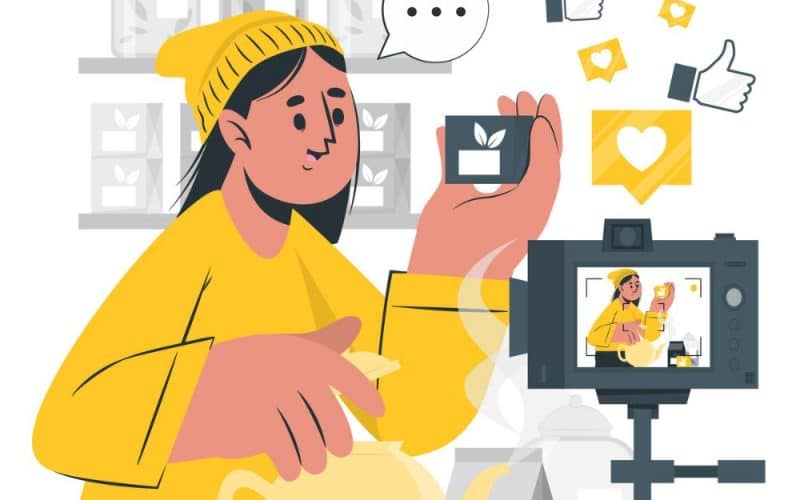I’m very sure we’ve all heard the saying, “there’s no such thing as bad press”. Unfortunately, that’s a big, fat lie, because having a bad reputation can be worse than having none at all. That is to say that media coverage can have a big impact on how people perceive your brand. This is where a media kit comes in.
A close cousin of the press kit, media kits can help you guide media/press conversation and position your product and business the way you want. They also make promoting and praising your brand easier. So, if you’d like to apply these perks to your business, then read on to find out what a media kit is, why they are so important, and how to create one.
Key Takeaways
- A media kit is a pre-packaged set of promotional materials that provides information about a business, product, or event.
- Its main purpose is to be the definitive source of information on a topic for journalists who want to write a story around it.
- A media kit can be as simple as a page on a company’s website or as complex as a package of information and product samples sent to selected media members.
- You can add whatever you want to your kit, but if earned media coverage is your goal then you need to get the basics right. These include a boilerplate, logos, contact information, and social media links, among others.
- Your kit should include a mix of important information about your business and useful resources that journalists or influencers will find helpful.
Media Kit: Definition
A media kit is a pre-packaged set of promotional materials that provides information about a business, product, or event. It is a promotional public relations tool that can serve several functions. These functions include promoting the launch of a new company or announcing the launch of a new product or service by an existing company.
The main purpose of a media kit is to be the definitive source of information on a topic for journalists who want to write a story around it. When companies create media kits, they ensure the journalists have the most recent, accurate, and up-to-date information on that topic.
You can present your company as you would like it to be seen and save time by eliminating the need for you or your employees to repeatedly answer the same questions.
Purpose Of Media Kits
In a nutshell, a media kit is used to gather information about your product or company to share with outside parties. Media kits don’t get you more media coverage, but they do make creating that content easier. They also help ensure that the content you produce aligns with your brand and positioning.
For example, if a magazine writes an article about you, your media kit will share the background information they need to do it in the right terms and tone of voice. Or, if someone is creating a social media video about you, they’ll know how they should use your logo or what colors are on the brand.
Overall, a media kit fosters convenience and consistency when working with an external partner.
What To Include In A Media Kit
By all means, you can add whatever you want to your kit, but if earned media coverage is your goal then you need to get the basics right.
Here are the key things that every media kit should include:
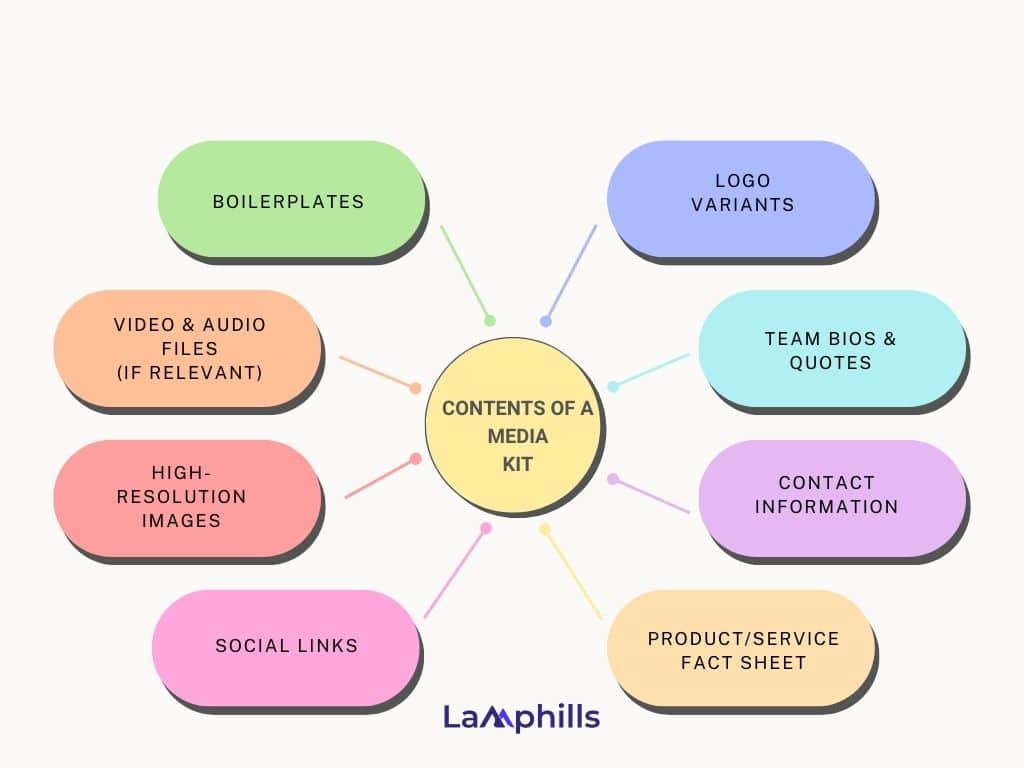
These have become basic parts of every media kit, and are designed to not jolt a journalist’s system with too much information. When starting out, try to stick to what is expected.
Key Components of a Media Kit
Your kit should include a mix of important information about your business and useful resources that journalists or influencers will find helpful.
Media Kit Information
- Mission statement: a brief explanation of what your organization wants to achieve.
- Company facts: size (headcount and or turnover), which countries you operate in, location of headquarters, and other major facilities.
- Products and services: what your company actually offers.
- Areas of expertise: any specialist knowledge and capabilities your company has.
- Brands: if your business owns multiple brands, list them all.
- Company history: a timeline of major milestones for your business, from its founding to the present day.
- Leadership team: names and roles of senior executives.
- Contact information: specifically, the contact details to be used for media inquiries about your organization.
- Social media: links to all of your organization’s social media channels.
- Legal & regulatory information: depending on your market and industry, there may be important legal and compliance information that you should make readily available.
- Press center: your press center (if you have one) is where press releases, news and updates are published. Hence, it’s closely related to your media kit, and the two should feature clear navigation links to one another. Often a media kit and press center are bundled together, and the terms can be used interchangeably.
Media Kit Resources
- Photo library: high-quality photographs of your senior executives, your offices and facilities, products, and anything else that would be of interest to people who want to know more about your business.
- Logos: copies of your logo in different sizes and formats for use online and in print.
- B-Roll video: generic video clips relating to your business, that could be used in broadcast media or online video.
- Case studies: you don’t need to include every case study, but if you have some particularly impressive ones, it’s a good idea to put them where journalists can find them.
- Testimonials: as well as full-blown case studies, some positive quotes and recommendations from customers, partners, journalists, and influencers will be helpful.
Building a Media Kit
A media kit should address your specific business’s publicity and communication needs. It should demonstrate your creativity and value while being informative and easily understood. It should also convey everything outsiders need to know about your business, packaged up and ready to introduce you to anyone.
Finally, you should put enough effort into your kit to be proud of it.
A kit can be as simple as a page on a company’s website or as complex as a package of information and product samples sent to selected media members. The kit commonly provides the company’s official name and:
- The names, titles, and biographies of executives and leadership
- Information about the company’s history and function
- Photos and any relevant and positive press releases
- Contact information for reporters
How to Make a Media Kit (Everything You Need)
Free Media Kit Templates
While you can build a kit from scratch, I recommend saving time (and preventing design headaches) using a free template. These templates give you a building framework—you’ll just pop in your copy and swap in your assets.
Here’s a list of the best places to find free media kit templates:
These resources all include downloadable templates, and some even include drag-and-drop design builders. Play around with these free options before you decide to build one from scratch—there’s a good chance they already have what you need. Also outlined below are some additional tips and tricks that can help you create the perfect kit.
Awesome Hacks to Creating the Perfect Media Kit
Where Should I Keep My Media Kit?
After you’ve created your media kit, you’ll need to decide where it is going to live. After all, you brought it to life, and just like a baby, you can’t just leave it out on the street.
In the old-school days of PR, you had to send a kit via the post or have it delivered by hand. Nowadays digital media kits ensure you can swap, update, and change any aspect of your kit whenever you like, making it easy to keep information up to date and adapt it to particular audiences.
With the advent of the digital era, you can simply share links to your kit and even monitor how many people visit it using an analytics platform like Google Analytics.
Option 1: An online or electronic media kit
In the present digital age, this really should be your go-to choice for three simple reasons:
- It’s easy to update
- It’s easy to share
- It’s easy to adapt
With an electronic media kit, you would only need to update a file one time. From that moment on, anyone with the link to your kit will automatically see your most up-to-date content. Easy, right?
It’s also worth saying that your media kit must be easy to find and access. Journalists generally know that the media link lives down in the footer of any webpage, so make sure to link to your press area in the footer of your website.
Option 2: A media kit PDF
A relic from the bygone days of snail mail, having a PDF version of your media kit is often a necessary evil. Importantly, it serves a different purpose than the online version.
For one, a PDF kit must be short; think one page of A4. For two, the main reason you will ever want to have a PDF version of your media kit is to have something to print and physically distribute at an event, or to slip into a journalist’s dossier when they aren’t looking. Seriously, these are niche circumstances.
Key point: Where your online content can be downloaded and its assets immediately used in stories about your brand, a PDF serves only to inform.
This is why your printable kit should focus on a particular audience or occasion. At most, it should contain:
- Your boilerplate tailored to your audience (e.g. the event’s attendees)
- A very brief outline of your product/news
- A quote from a relevant person at your business
- Contact details, including name, email, phone, social profiles, website
- Branding in the letterhead or some visuals used sparingly
The limits of a PDF are many, chief among them:
- Once you distribute it, it’s out of your hands – so no chance to keep it updated
- You can’t include media for journalists to use
- If emailing, your recipient’s server could flag the attachment as spam
World-Class Media Kit Examples
All brands handle media kits slightly differently, depending on the unique demands of their business, but we can learn by looking at how some of the world’s biggest organizations do it.
Microsoft
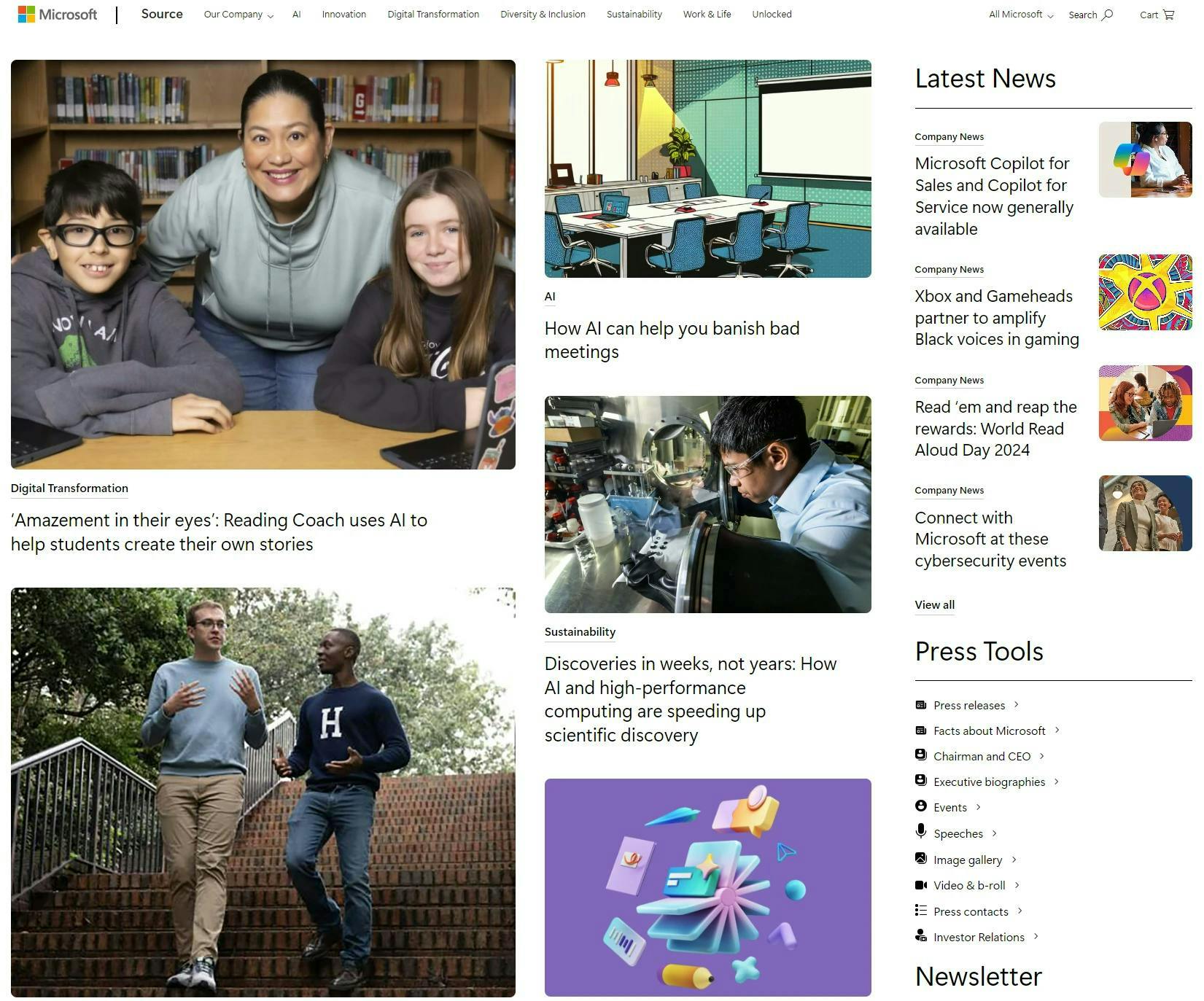
As you would expect from one of the biggest tech brands in the world, Microsoft has a truly excellent media kit in its online newsroom, with a comprehensive set of assets available. Everything is laid out cleanly, with a simple navigation system that makes getting to the content you need a piece of cake.
Nike
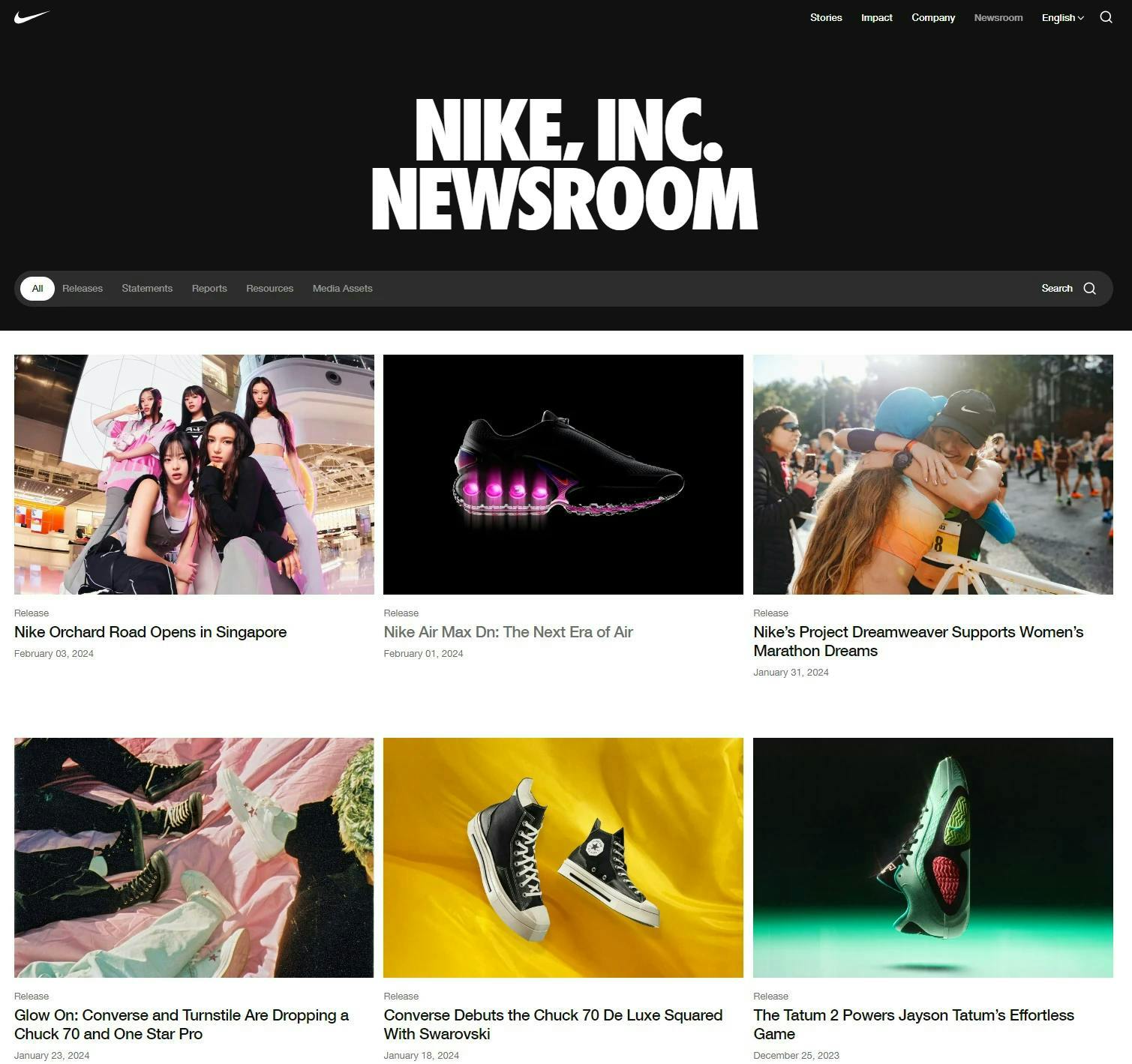
Nike’s media kit is a showcase of design simplicity, which makes sense for a sportswear brand where visuals are important. All of the critical information is easily available, but it’s primarily highlighted through the use of striking imagery.
Toyota Prius
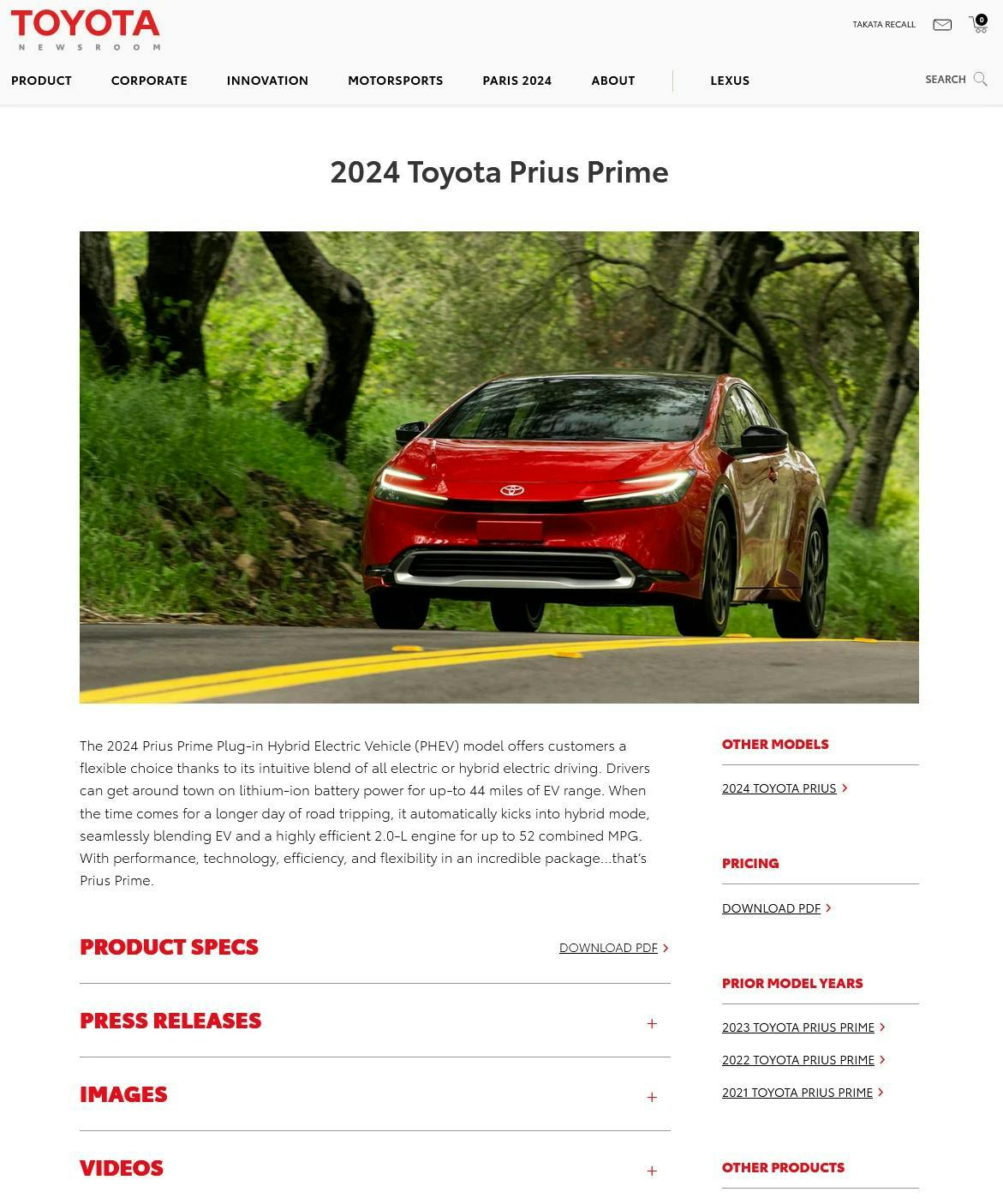
This is a great example of a media kit for a single product, in this case, the 2024 Toyota Prius. Toyota manufactures a lot of different vehicles, and the Prius is one of its flagship product brands, which is of interest to journalists and influencers all around the world.
The Toyota Prius media kit contains images, videos, technical details about the vehicle, and the latest relevant news about it, such as awards it has won.
PepsiCo
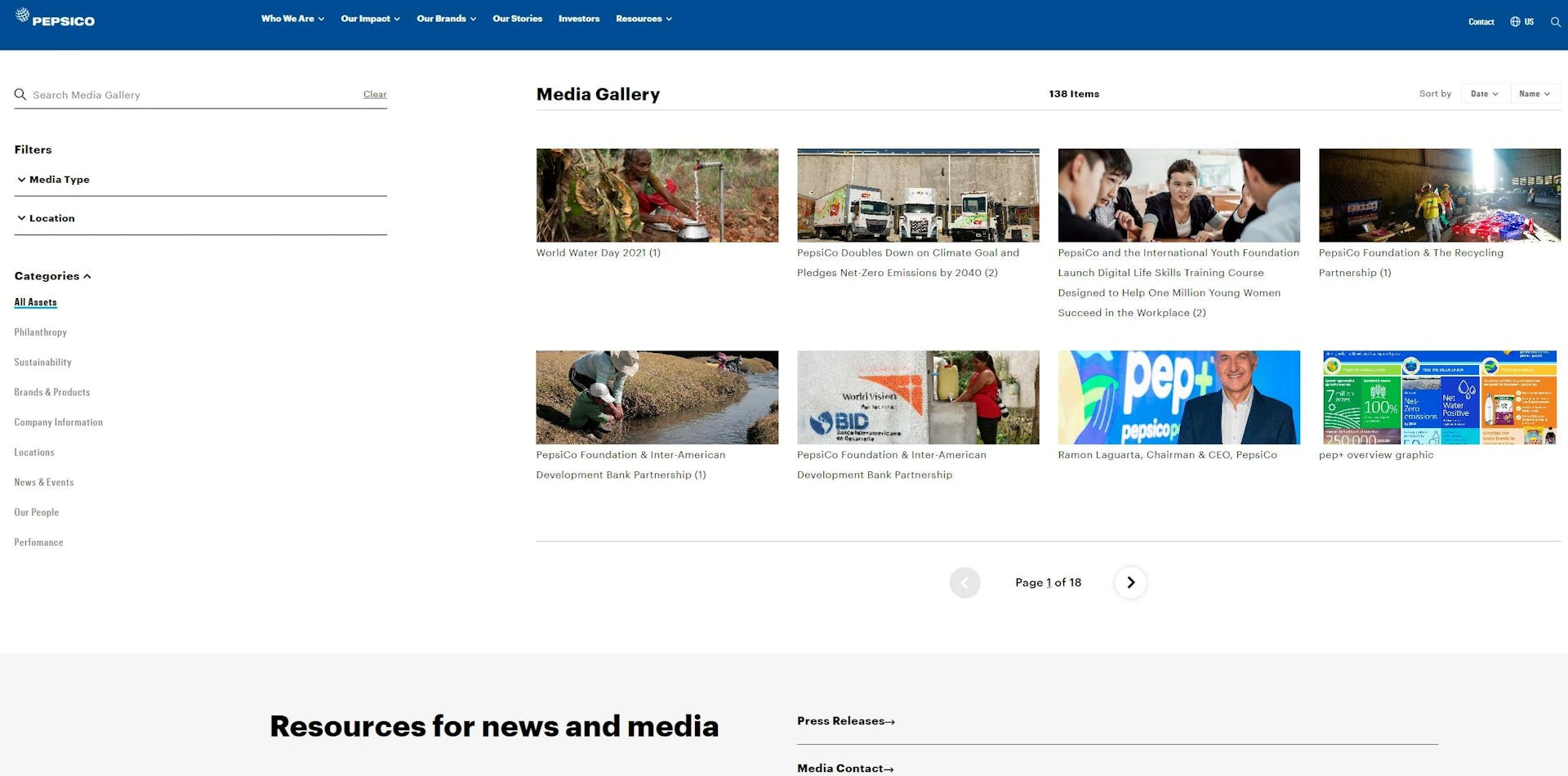
PepsiCo’s media kit provides a wide range of assets, all accessibly organized, and quick links to global media contacts, all within one click of the main page. Despite being a massive company with lots of brands and markets, the media kit is straightforward and simple to use, making it easy for journalists to get what they need.
Media Kit vs Press Kit: What’s The Difference?
The two terms are similar and, in general, they describe a collection of promotional materials collected for media representatives. They are commonly used interchangeably too, but there are slight differences that you should be aware of.
A press kit is a more traditional term, describing materials for the press or journalists. This includes press releases, images, background information, and contact details.
A media kit is a more modern term that describes materials for a different audience – bloggers, influencers, content creators, and others. Besides press releases and images, a media kit contains other media formats, such as videos, infographics, statistics, social media profiles and more.
Both solve the same problem – offering relevant information to people who may be willing to talk about and promote a brand, event, person or something else.
Recommended Articles
- How to Get More YouTube Subscribers Free: No Ads, No Spending a Dime
- BROADCAST MEDIA: Best Practices In 2024 (Updated!)
- The Best Canva Alternatives for Every Budget
- How To Write a Human Interest Story: Detailed Guide
- How Much Do Social Media Influencers Make? Income Breakdown
- How To Measure Reach: Effective Tools and Strategies
